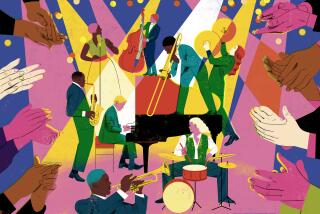An education in the global language of jazz
Every year around this time, 8,000 or so folks with a special interest in jazz get together for a unique celebration of the music. This year, the International Assn. for Jazz Education convened at the Long Beach Convention & Entertainment Center from Wednesday through Saturday.
The offerings covered every imaginable area, including academic papers and performances by world-class artists. But with as many as 10 events taking place simultaneously, it was impossible for anyone to fully experience the sumptuous banquet of music, ideas and information.
The highest-visibility programs featured, among others, pianists Geri Allen and Herbie Hancock; drummer Roy Haynesâ Fountain of Youth band; the Gerald Wilson Orchestra with Dee Dee Bridgewater; saxophonist James Moody; drummer Chico Hamilton; the Bad Plus; saxophonist Bud Shank; guitarist Kenny Burrell; and singers Tierney Sutton, Dianne Schuur, Mary Stallings and Monica Mancini.
Among the honors bestowed was the IAJE Presidentâs Award, presented to Hancock at a Wednesday night gala that included a musical tribute to Brazilian bossa nova artist Joao Gilberto.
On Friday night, a special concert celebrated the recipients of 2005 National Endowment for the Arts Jazz Masters Fellowships -- Burrell, clarinetist-saxophonist Paquito DâRivera, composer-trombonist Slide Hampton, singer Shirley Horn, keyboardist Jimmy Smith, jazz promoter George Wein and the late clarinetist Artie Shaw.
The most intriguing events, however, took place beyond the glittering galas, awards and jazz celebrities. Most were presented by performers, educators, clinicians and jazz advocates who were far less known. But it was their presence that provided the real sense of jazz as a global art form.
There was, for example, an adventurous, envelope-stretching performance by the Swedish Jazz Federation Youth All-Stars; a spirited, groove-driven program by the East Midlands Youth Jazz Orchestra from Great Britain; as well as sets by the UCT/UKZN Combo from South Africaâs University of Kwazulu-Natal; the Brisbane All Star Youth Big Band from Australia; and Israelâs T.Y.J.D. Ronen Septet.
Panel discussion topics included such practical matters as âJazz in the Digital Worldâ and guidelines on how to appeal to younger audiences in âIt Donât Mean a Thing if It Ainât Got Bling-Bling.â Clinics were similarly far-reaching, offering opportunities to explore âContemporary Harmony From Wayne Shorter to Peter Gabriel,â âReconnecting Teens With the Jazz Vocal Traditionâ and âAfro-Peruvian Jazz Music.â
And there were dozens of other performances, panels and clinics. In sum, they represented the central role of the association as the most significant advocate for the propagation and expansion of jazz education.
Still, somewhere beneath the nonstop activity, the perennial question of methodology remained. Jazz has historically been learned in the trenches, by the rote process of doing, often by following the modeling templates of much-admired mentors.
The proliferation of jazz academic activity over the last few decades -- most of it employing techniques long established in the classical music world -- has produced a generation of technically skilled young players.
But it remains to be seen whether it can produce innovative artists at the level of, say, a Charlie Parker, Miles Davis or Bill Evans.
More to Read
The biggest entertainment stories
Get our big stories about Hollywood, film, television, music, arts, culture and more right in your inbox as soon as they publish.
You may occasionally receive promotional content from the Los Angeles Times.










